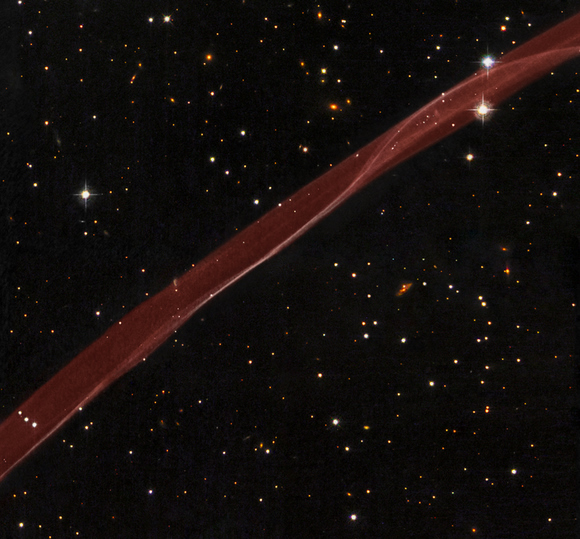Back in 1006 A.D, observers from Africa to Europe to the Far East witnessed and recorded the arrival of light from what is now called SN 1006, a tremendous supernova explosion caused by the final death throes of a white dwarf star nearly 7,000 light-years away. One Egyptian astronomer recorded the object was 2 - 3 times as large as the disc of Venus and about one quarter the brightness of the moon. The supernova was probably the brightest star ever seen by humans, visible even during the day for weeks, and it remained visible to the naked eye for at least two and a half years before fading away. Remnants of this supernova are still visible to telescopes, and the Hubble Space Telescope captured this close-up a filament of the shock wave of the explosion, still reverberating through space, seen here against the grid of background stars. The full image of SN 1006 is pretty impressive, too…
SN 1006 has a diameter of nearly 60 light-years, and it is still expanding at roughly 6 million miles per hour. Even at this tremendous speed, however, it takes observations typically separated by years to see significant outward motion of the shock wave against the grid of background stars. In the Hubble image shown here, the supernova would have occurred far off the lower right corner of the image, and the motion would be toward the upper left.
It wasn't until the mid-1960s that radio astronomers first detected a nearly circular ring of material at the recorded position of the supernova. The ring was almost 30 arcminutes across, the same angular diameter as the full moon. The size of the remnant implied that the blast wave from the supernova had expanded at nearly 20 million miles per hour over the nearly 1,000 years since the explosion occurred.
In 1976, the first detection of exceedingly faint optical emission of the supernova remnant was reported, but only for a filament located on the northwest edge of the radio ring. A tiny portion of this filament is revealed in detail by the Hubble observation. The twisting ribbon of light seen by Hubble corresponds to locations where the expanding blast wave from the supernova is now sweeping into very tenuous surrounding gas.
The hydrogen gas heated by this fast shock wave emits radiation in visible light. Hence, the optical emission provides astronomers with a detailed "snapshot" of the actual position and geometry of the shock front at any given time. Bright edges within the ribbon correspond to places where the shock wave is seen exactly edge on to our line of sight.
Original News Source:
HubbleSite
 Universe Today
Universe Today
